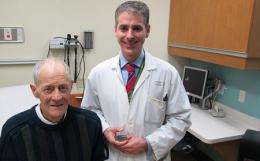New type of pacemaker perfect for patients with less severe symptoms

Victor Timmins was having trouble doing even the simplest tasks; even walking was difficult.
“My health was failing,” said Timmins. “I couldn’t do anything; I was completely pooped.”
After living with fairly severe heart failure, Timmins received the newest type of pacemaker called cardiac resynchronization therapy in February of 2009. It allows both the left and right ventricles to synchronize and beat together.
Timmins was a perfect candidate for this pacemaker because of his symptoms. It’s people with less severe symptoms that are harder to treat. But Justin Ezekowitz, a cardiology researcher in the Faculty of Medicine & Dentistry at the University of Alberta, has found that people with less severe symptoms than Timmins will do well with this device. This was a discovery not anticipated by the larger cardiology community.
Ezekowitz and his team, including a U of A graduate student, conducted a systematic review of 25 clinical trials involving patients who have less severe symptoms of heart failure. The U of A group found this new type of pacemaker decreased illness and death rates in these patients. The findings are published in February’s Annals of Internal Medicine.
“Many cardiologists had felt that the best bang for your buck with these pacemakers was in the more severe patients, because getting a large benefit in less symptomatic patients is actually quite difficult to achieve with heart-failure therapy,” said Ezekowitz.
One of the largest studies his team reviewed was done in Ottawa. Given the length of this trial and its rigour, especially when considered along with the results of another trial that had similar results, it’s quite clear this therapy can help this group of patients, Ezekowitz said.
As well as reducing illness and death rates, use of this pacemaker reduces the number of hospital visits from patients in this group, so there’s also potential for lowering health-care costs.
“A cost-benefit analysis needs to be done,” said Ezekowitz. “Generally, if you think that at least half of expenses for heart failure are hospitalization-based, anything that reduces that hospitalization burden is likely to have some incremental benefit.”
The findings of this scientific systematic review will likely influence the recommendations of clinical practice guideline committees and change how these patients are treated. In Edmonton, Ezekowitz says it is likely change will happen quickly.
“Our electro-physiologists are already open to changing their practice, effective immediately,” said Ezekowitz.
As Timmins is showing, it’d be hard to deny the benefits of this device for heart failure patients. His health has improved so much he’s hoping to get back to swimming.
“I’ve been great since, I can do things I couldn’t do before,” said the 81-year-old. “You don’t need to worry about your heart; this is an aid to keep it in rhythm. Without it I don’t think I’d be talking to you today.”















